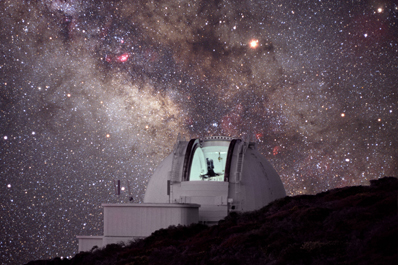|

The black cloud set to blossom into a giant star
BY KEITH COOPER
ASTRONOMY NOW
Posted: 10 June, 2009
A freezing cold, dark cloud of molecular hydrogen is beginning to stir up the materials for building a giant star, or even several massive stars, in a forbidding region of the Milky Way known as the Aquila Rift. This is the judgement of new observations made by the Submillimetre Array (SMA) on Mauna Kea in Hawaii.

The Aquila Rift is clearly seen in this image of the Milky Way rising over the Isaac Newton Telescope on La Palma in the Canary Islands. Image: Nik Szymanek.
The Aquila Rift is a dark split in the Milky Way, visible in the constellation Aquila and running up to Cygnus. It’s not dark because there is nothing there; rather there are inky black clouds of molecular hydrogen 23,000 light years away that blot out the starlight beyond. The sprinkling of stars that we can see inside the rift are all in the foreground.
Sun-like stars begin to form when cold molecular hydrogen gas clouds begin to collapse under their own gravity, eventually condensing into stellar objects. However, because massive stars are rare, we have never seen the embryonic stages of these stars’ lives, until now.
The SMA is the only instrument capable of detecting the far-infrared radiation from these dark nebulae; the gas is too cold for even the Spitzer Space Telescope to detect. Yet in this gas within the Aquila Rift, an object known as a ‘dark core’ has been discovered by a team of astronomers led by Dr Jonathan Swift of the University of Hawaii, who presented the latest findings at the American Astronomical Society Meeting in California this week.

A colour composite mid-infrared image of the region of the Aquila Rift containing the dark core, with contour lines marking out the core, which can only be detected at far-infrared wavelengths. Image: J Swift/NASA/JPL–Caltech/E Churchwell (University of Wisconsin) and James Clerk Maxwell Telescope/Joint Astronomy Centre.
This dark core is a clump of quiescent gas, equal to the mass of 120 Suns and no warmer than 18 degrees above absolute zero, all compressed into a region no larger than our Solar System. A dark core of this density is what models predict we should find if massive stars (over eight times the mass of the Sun but potentially much, much larger) were to form in the same way as more modestly sized stars.
“The mass and density of this object along with the lack of evidence for star formation is unique, and this fits very well with our expectations for massive pre-stellar cores,” says Swift. That said, theoretical models predict that star-formation could be kick-started and form massive stars in as little as 50,000 years. The radiation from massive stars can quickly destroy the environments in which they grow up, and this incredibly fast process (on galactic timescale anyway) means that finding dark cores is a rare occurrence. This just highlights how important this discovery in the Aquila Rift is to our understanding of the birth and evolution of the most enormous stars in the Universe.
|



